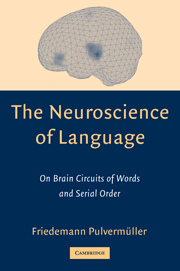Book contents
- Frontmatter
- Contents
- Preface
- The Neuroscience of Language
- 1 A Guide to the Book
- 2 Neuronal Structure and Function
- 3 From Classic Aphasia Research to Modern Neuroimaging
- 4 Words in the Brain
- Excursus E1 Explaining Neuropsychological Double Dissociations
- 5 Regulation, Overlap, and Web Tails
- 6 Neural Algorithms and Neural Networks
- 7 Basic Syntax
- 8 Synfire Chains as the Basis of Serial Order in the Brain
- 9 Sequence Detectors
- 10 Neuronal Grammar
- 11 Neuronal Grammar and Algorithms
- Excursus E2 Basic Bits of Neuronal Grammar
- Excursus E3 A Web Response to a Sentence
- 12 Refining Neuronal Grammar
- Excursus E4 Multiple Reverberation for Resolving Lexical Ambiguity
- Excursus E5 Multiple Reverberations and Multiple Center Embeddings
- 13 Neurophysiology of Syntax
- 14 Linguistics and the Brain
- References
- Abbreviations
- Author Index
- Subject Index
3 - From Classic Aphasia Research to Modern Neuroimaging
Published online by Cambridge University Press: 15 December 2009
- Frontmatter
- Contents
- Preface
- The Neuroscience of Language
- 1 A Guide to the Book
- 2 Neuronal Structure and Function
- 3 From Classic Aphasia Research to Modern Neuroimaging
- 4 Words in the Brain
- Excursus E1 Explaining Neuropsychological Double Dissociations
- 5 Regulation, Overlap, and Web Tails
- 6 Neural Algorithms and Neural Networks
- 7 Basic Syntax
- 8 Synfire Chains as the Basis of Serial Order in the Brain
- 9 Sequence Detectors
- 10 Neuronal Grammar
- 11 Neuronal Grammar and Algorithms
- Excursus E2 Basic Bits of Neuronal Grammar
- Excursus E3 A Web Response to a Sentence
- 12 Refining Neuronal Grammar
- Excursus E4 Multiple Reverberation for Resolving Lexical Ambiguity
- Excursus E5 Multiple Reverberations and Multiple Center Embeddings
- 13 Neurophysiology of Syntax
- 14 Linguistics and the Brain
- References
- Abbreviations
- Author Index
- Subject Index
Summary
In this chapter, an introduction to facts known from neurological, neuropsychological, and neuroimaging research on language is given. How the obtained results can be explained and how they fit together is discussed.
Aphasiology
The scientific study of language proliferated in the second half of the nineteenth century. Apart from linguists and psychologists, neurologists focused on language in the context of the then new findings about “affections of speech from disease of the brain” (Jackson, 1878). In adults who had been fully able to speak and understand their native language, a stroke, tumor, trauma, or encephalitis was sometimes found to severely and specifically reduce their language abilities. Such language disturbances were called aphasias. There was, and still is some discussion as to whether there are subtypes of aphasia, and a good deal of the research on aphasia was dedicated to developing new classification schemes and arguing why one scheme should be a better reflection of what appeared to be the truth than another. The research effort resulted in numerous classification schemes (Caplan, 1987) and also in what appeared to be an extreme position expressed by the claim that there is only one type of aphasia (Marie, 1906).
This last view can be based on the common features of all – or at least the large majority of – aphasias. All aphasics have difficulty speaking, although their ability to move their articulators – lips, tongue, pharynx, larynx, and other muscles in the mouth-nose region – may be well preserved.
- Type
- Chapter
- Information
- The Neuroscience of LanguageOn Brain Circuits of Words and Serial Order, pp. 33 - 49Publisher: Cambridge University PressPrint publication year: 2003



